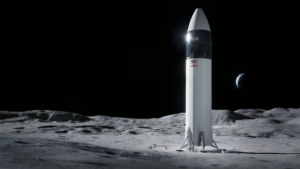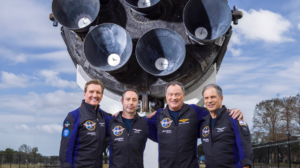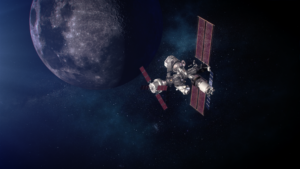
The Moon Lander Vulcan Just Launched Is In Trouble
Yesterday at 2:18 am EST, for the first time ever ULA’s new rocket Vulcan lifted off. Here we saw some brand new components including two Blue Origin BE-4 engines take their maiden flight among other hardware. While the launch itself went perfectly, one of the main payloads aboard ran into issues early into its journey.
Specifically, the Moon lander named Peregrine, which was set to be the first private spacecraft to land on the Moon, was reported to have suffered a serious anomaly in its propulsion system. A big enough issue that it likely won’t land on the Moon and complete its mission. Here I will go more in-depth into the first flight of Vulcan, what’s going on with the Peregrine lander, the future of this hardware, and more.
Vulcan’s First Flight

Yesterday on the 8th, Vulcan was on the pad and ready for liftoff. Right before the clock hit zero the BE-4 engines began ignition and with the help of the two SRBs, the rocket lifted off for the first time. From here it began accelerating and reached max Q at T+1:16 into the launch. We then saw the two SRBs jettison at T+1:50. It continued to gain altitude until nearly 5 minutes in when the two BE-4 engines successfully cut off and then the booster separated just seconds later. Currently, this entire rocket is expendable but ULA has plans for the future to possibly protect and reuse a section of the booster and engines.
At T+5:15 the two upper stage engines ignited and then the payload fairing jettisoned right after revealing the Peregrine lunar lander at the top. The next 30 or so minutes consisted of a coast phase and additional engine burn before the lander separated from the upper stage at T+50:26 into the flight. The upper stage went on to complete one more engine burn with the mission officially finishing close to 4 and a half hours after liftoff. This marked a successful flight and operation of the Vulcan rocket.
While exciting, not long after, this good news was countered by reports that the Peregrine lander was running into issues. Astrobotic, the company responsible for the lander came out with an initial update that was quoted saying, “After successfully separating from United Launch Alliance’s Vulcan rocket, Astrobotic’s Peregrine lunar lander began receiving telemetry via the NASA Deep Space Network. Astrobotic-built avionics systems, including the primary command and data handling unit, as well as the thermal, propulsion, and power controllers, all powered on and performed as expected. After successful propulsion systems activation, Peregrine entered a fully operational state. Unfortunately, an anomaly occurred, which prevented Astrobotic from achieving a stable sun-pointing orientation. The team is responding in real-time as the situation unfolds and will be providing updates as data is obtained and analyzed.”
A few hours later they released a second update that mentioned concerns with landing on the Moon and the battery reaching an operationally low level. Soon after that update, they managed to successfully re-establish communication with Peregrine after the blackout. They also reoriented the solar panels toward the sun allowing the battery to charge.
On the fourth update they said, “Unfortunately, it appears the failure within the propulsion system is causing a critical loss of propellant. The team is working to try and stabilise this loss, but given the situation, we have prioritized maximizing the science and data we can capture.” They then received some of the first images of the lander taken by an onboard camera. Astrobotic pointed out that this image gave a visual clue that aligned with their telemetry data about a propulsion system anomaly. With all this in mind, it seems clear now that the opportunity to land on the Moon is gone.
The vehicle no longer possesses the fuel or necessary systems to make a successful landing. Instead, the teams plan to use the working tech onboard to complete as much science as possible. In one last tweet, they said, Nonetheless, the spacecraft’s battery is now fully charged, and we are using Peregrine’s existing power to perform as many payload and spacecraft operations as possible. Adding to everything, when asked who was at fault Tory Bruno responded, “The Vulcan portion of the mission was flawless. Sadly, Peregrine has had an issue, but the @astrobotic team is working hard to preserve the ability to perform some valuable science.”
Vulcan’s Successful Flight

While the current state of the Peregrine lander is far from ideal, the launch itself was still a major success for both United Launch Alliance and also Blue Origin. This first mission, named Certification-1 or Cert-1. was the first of two flight tests required for ULA’s certification process with the U.S. Space Force. For years now ULA has worked in close partnership with the Space Systems Command throughout the design, development, testing and production of the new rocket for future access to space. With this launch complete, ULA is one step closer to being fully certified and beginning to launch much more frequently.
For a while now in the lead up to Vulcan’s first launch, we have heard ambitious estimates about the frequency of this vehicle’s future schedule. In one example, ULA CEO Tory Bruno said, “We have to ramp up, before the end of 2025 we expect to be really at a tempo, which is flying a couple of times a month, every two weeks” he said.
This amount of engines comes out to around 48 BE-4 engines a year. It’s also important to point out that United Launch Alliance has priority when it comes to receiving these engines. This means that Blue Origin will need to make enough engines for Vulcan and ULA first and then additional ones for each New Glenn booster. In addition, Amazon’s satellite service, project Kuiper, selected Vulcan for 38 launches. By 2026, Amazon’s FCC license requires that at least half of the satellites are in orbit and operational. This suggests that a majority of Vulcan’s launches will be expected to happen before 2026. This means the vehicle is going to be very busy.
The successful flight is also a big deal for Blue Origin as it marks the first flight of the BE-4 engine. Even though this hardware has been tested extensively for many years now, this was the first time it was actually lifting a rocket into space. The success is a good sign not only for future deliveries to ULA but also plans for Blue Origin’s New Glenn rocket, which uses seven of these engines on the first stage. In recent months we have seen this specific engine’s production go into overdrive. Since Vulcan is expendable, every launch means two more BE-4 engines are needed. It’s possible the total 38 launches require 76 BE-4 engines. Combine this with additional contracts and plans and the two companies are expecting a very busy upcoming few years.
As far as when the next launch is, ULA already has hardware nearly ready. At this point, we know the company has already been working to mass-produce this vehicle in preparation for a busy launch schedule. Back on November 3rd, Tory Bruno tweeted saying, “Wow. That kind’a looks like 4 Centaur V’s in flow at the Rocket Factory…” Here you could see all the upper stages with varying progress in the factory. By now the next Vulcan booster and upper stage should be practically complete. If so, they would need to ship to the Florida launch site, complete a wet dress rehearsal, then static fire, and launch Dream Chaser. The successful flight is a good sign for the schedule of Dream Chaser which should be just about ready to ship in the coming months.
Looking at the design of Vulcan, while nothing specifically stands out as a next-generation launch vehicle, it is powerful, expected to be incredibly reliable, and the future workhorse of ULA. The two main BE-4 engines produce 550,000 pounds (2,400 kN) of sea level thrust. To add to that, two graphite epoxy motor (GEM) 63XL solid rocket boosters (SRBs) generate the additional power required at liftoff, with each providing 459,600 lbs (2,044 kN) of thrust. Above is the Centaur V second stage, which is 17.7 ft (5.4 m) in diameter and 38.5 ft (11.7 m) in length. Its propellant tanks are pressure-stabilized and constructed of corrosion-resistant stainless steel. Centaur is a cryogenic vehicle, fueled with liquid hydrogen and liquid oxygen, powered by two RL10C-1-1A engines producing 23,825 pounds (106 kilo-Newtons) of thrust. Both of which were reported to have performed very well on this first flight.
Finally, at the very top, the spacecraft is encapsulated in a 5.4-m- (17.7-ft-) diameter payload fairing (PLF), a sandwich composite structure made with a vented aluminum-honeycomb core and graphite-epoxy face sheets. The bisector (two-piece shell) PLF encapsulates the spacecraft. The payload attach fitting (PAF) is a similar sandwich composite structure creating the mating interface from spacecraft to second stage and payload fairing. While also expendable, Tory Bruno commented that they might work to reuse these in the future, however, he mentioned that they are reasonably priced which is a big upside.
At the end of the day, Vulcan is now officially beginning its long journey and hopeful future. ULA plans to use this rocket as much as possible for all sorts of missions ranging from LEO to beyond.
Conclusion
ULA just successfully completed the first Vulcan launch and deployed its included payloads. Unfortunately, the Peregrine Moon lander suffered a critical failure and is now in a rough state. We will have to wait and see how it progresses and the impact it has on the space industry.



